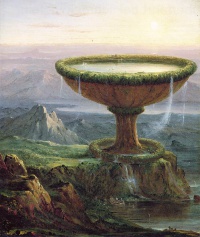The Titan's Goblet
From The Art and Popular Culture Encyclopedia
|
Related e |
|
Featured: |
The Titan's Goblet (1833) is an oil painting by the English-born American landscape artist Thomas Cole.
It is perhaps the most enigmatic of Cole's allegorical or imaginary landscape scenes. It is a work that "defies full explanation", according to the Metropolitan Museum of Art. The Titan's Goblet has been called a "picture within a picture" and a "landscape within a landscape": the goblet stands on conventional terrain, but its inhabitants live along its rim in a world all their own. Vegetation covers the entire brim, broken only by two tiny buildings, a Greek temple and an Italian palace. The vast waters are dotted with sailing vessels. Where the water spills upon the ground below, grass and a more rudimentary civilization spring up. Recognized as a unique artwork, The Titan's Goblet was the only pre-20th-century American painting included at the Museum of Modern Art's Fantastic Art, Dada, Surrealismexhibition of 1936.
It is featured in Arts fantastiques (1960) by Claude Roy.
See also


